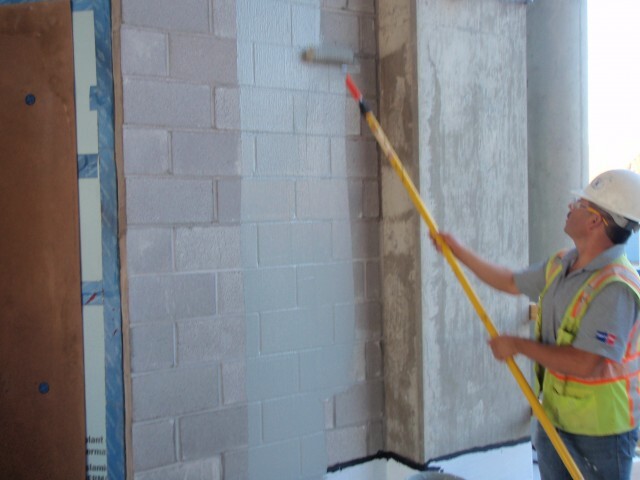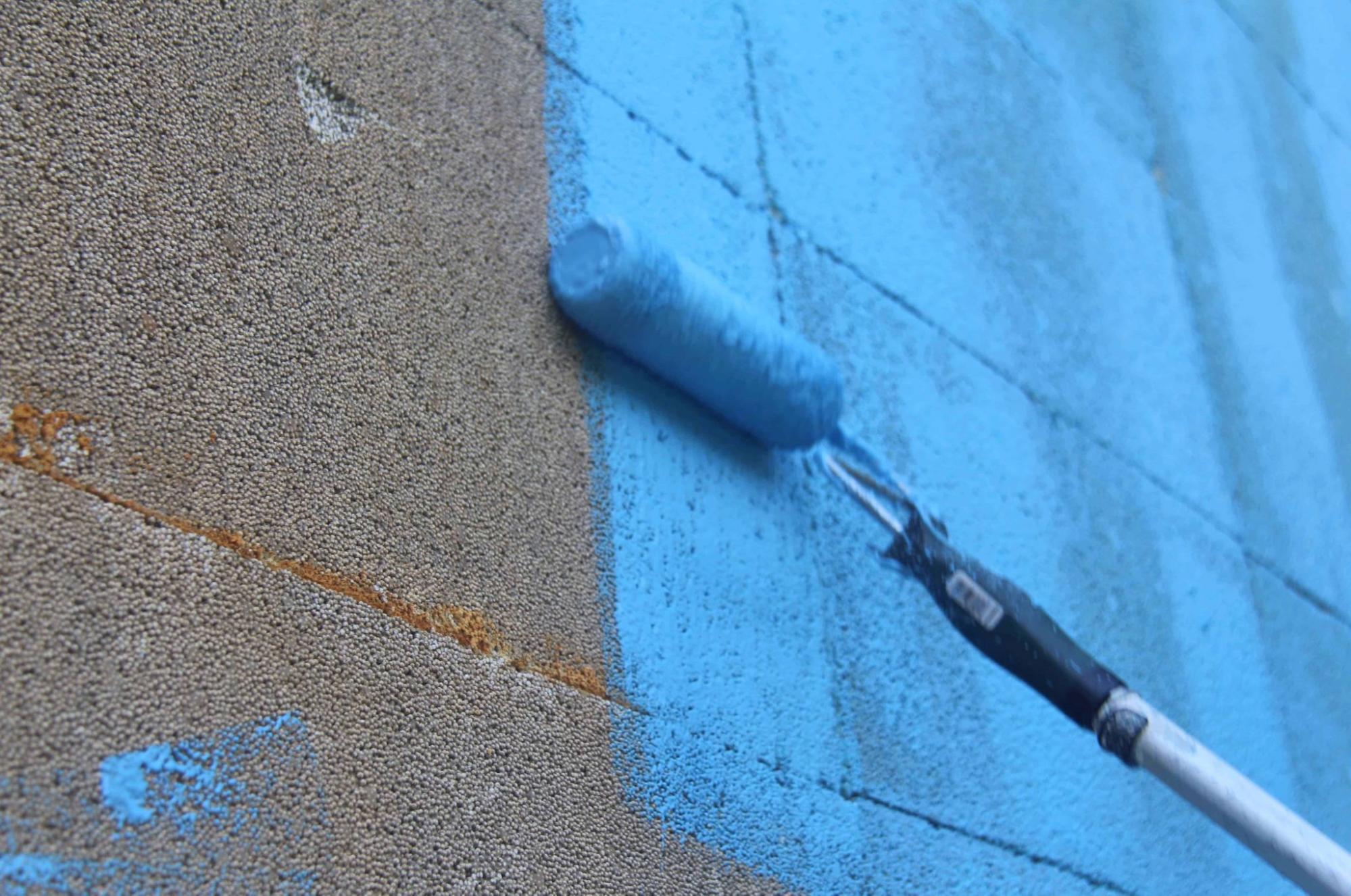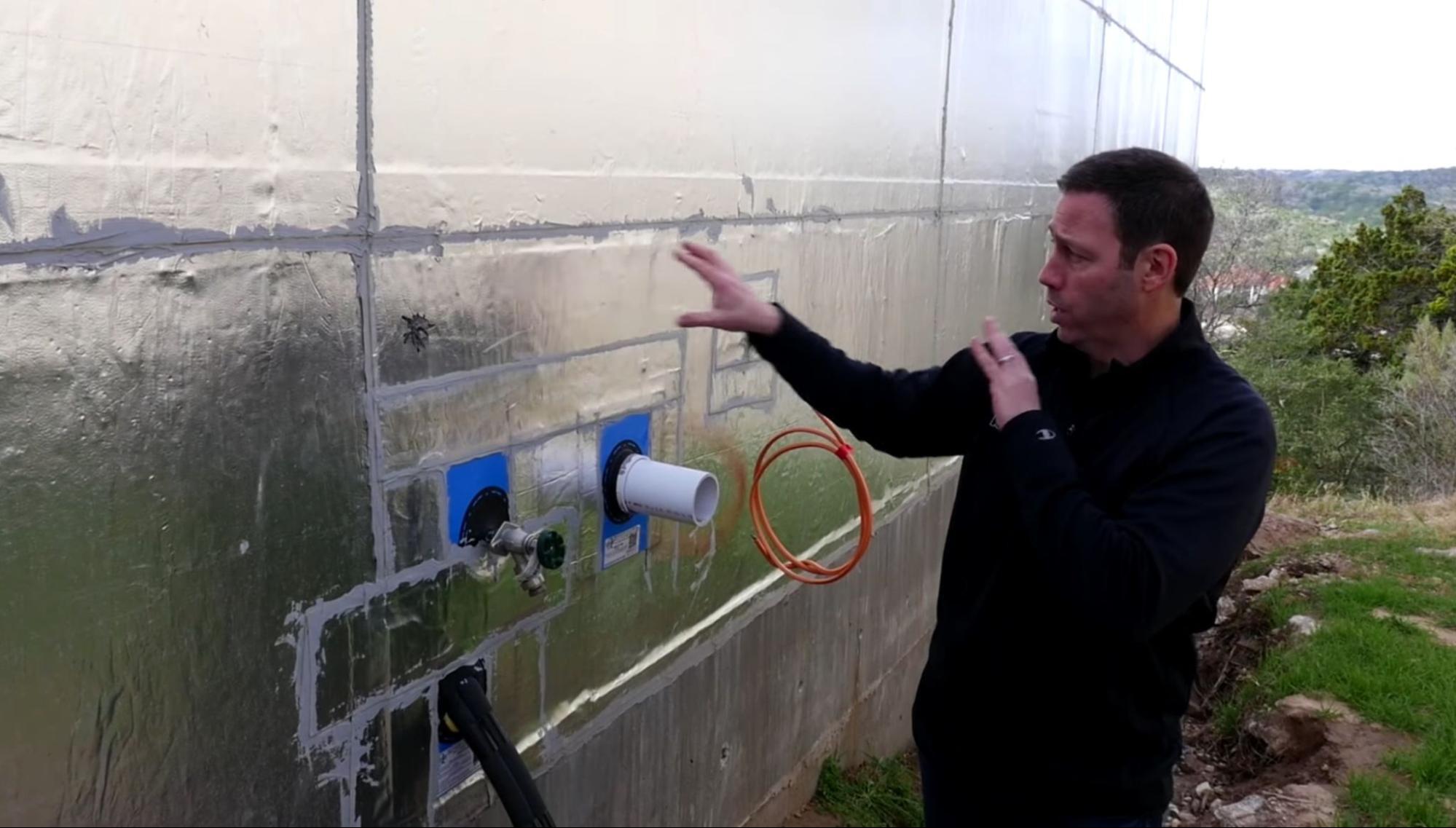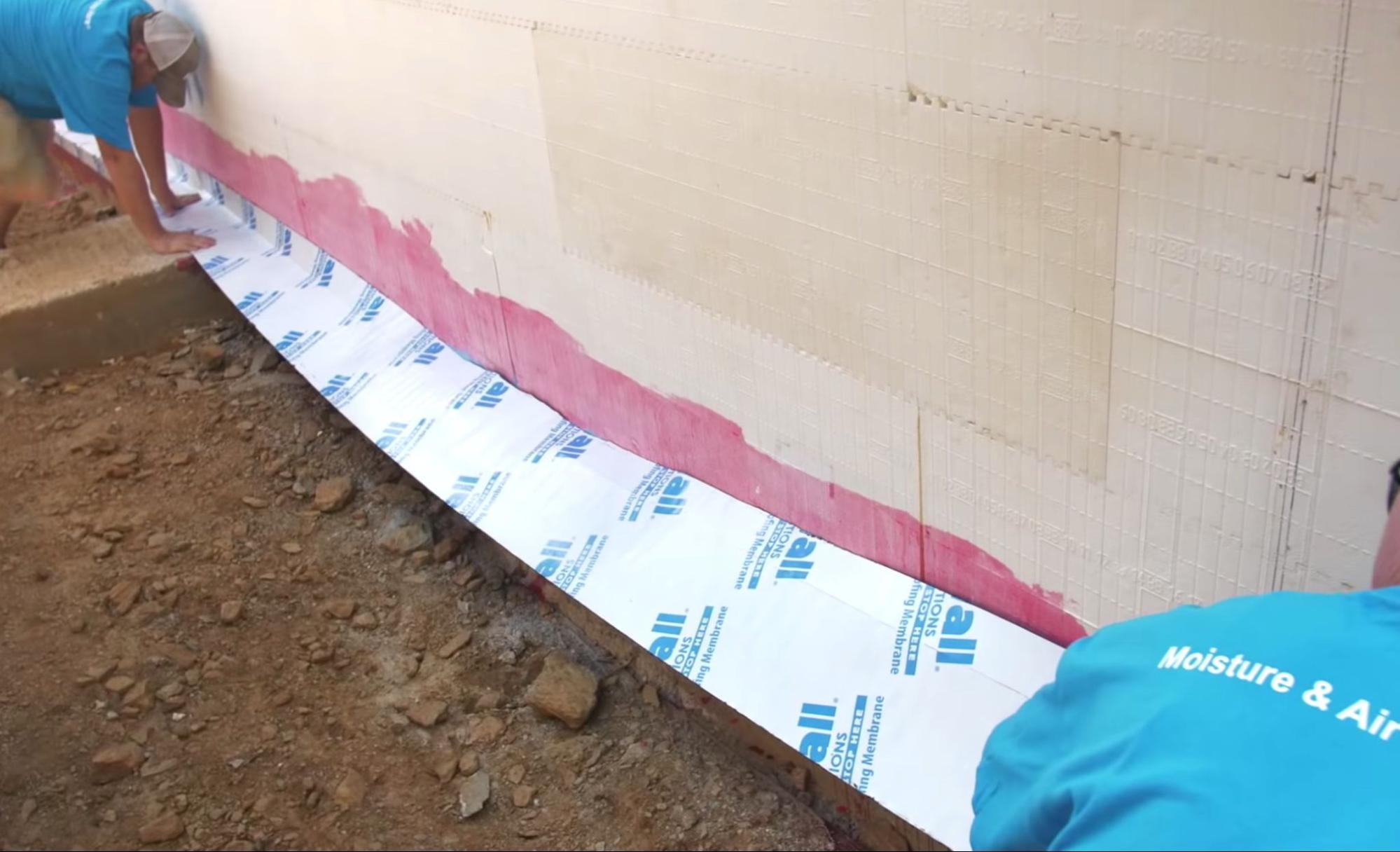It’s common to build a foundation or outbuilding from either concrete blocks or from poured concrete. Both types of foundations and walls have advantages — concrete blocks are a uniform size, stacking concrete blocks is sometimes easier than pouring a concrete wall, and concrete blocks are sometimes easier to get if there’s not a ready mixed plant nearby. Another benefit is that when a wall is made from a block, it’s already hardened and doesn’t need cure time.
However, concrete blocks have a disadvantage: They are more permeable to water and water vapor than poured concrete. It is imperative to use the best block wall waterproofing products on blocks.
All concrete materials have to be protected from water intrusion, but concrete blocks and cinder blocks are especially vulnerable. (Many people use the terms concrete blocks and cinder blocks interchangeably, but concrete blocks are heavier than cinder blocks.) The larger pores of concrete blocks vs. poured concrete make concrete blocks semi-permeable. According to the ASHRAE Handbook, the permeability of concrete (1:2:4 mix) is 3.2 perms per inch of thickness, whereas an 8- to 10-inch-thick poured concrete wall is about 0.4 to 0.3 perms. Once moisture intrudes into a block, it makes the pores even larger, which reinforces the cycle of damage to the structure.
Another reason you need cement block waterproofing is that the blocks have more joints and more areas to seal than a poured concrete foundation or wall. There are mortar joints on all sides of the blocks — they’re basically just oversized bricks, in a sense. The wall responds to any soil settlement and hydrostatic pressure, and over time, these joint areas develop hairline cracks. Plus, the mortar is less durable than the concrete, so it wears down over time and causes leaks.
For the best method for sealing concrete block walls and the best cinder block water barrier, read on.

1. Apply a Coating Directly On the Bare Wall
The first line of defense is a cinder block sealant. Polyguard’s Airlok Flex barrier systems provide an effective defense against air leakage and moisture intrusion. WG stands for Weather Guard, and WG LT stands for Weather Guard Low Temperatures. Both are water-based, permeable, above-grade air, weather and vapor coatings that are applied directly on the bare side of a block wall for an easy way to seal a concrete block foundation. Both coatings spray or roll on, and the WG LT is suitable for temperatures down to 20° F.

2. Use a Breathable / Permeable Barrier
The point of using block wall waterproofing products is to form a hydrophobic barrier within the block and on the surface of the block that repels moisture and vapor. At the same time, any moisture that is in the block already needs to be able to find a way out. For that, you need a permeable / breathable barrier like Polyguard’s PolyWall Blue Barrier Liquid Wrap 2300. It goes on as a spray, or can be rolled on. It can be used as a replacement for house wrap products because it bonds directly to the substrate.

3. Use a Weather-Resistant Elastomeric Layer
If a concrete block is not treated to repel water, it can absorb water during rains or other general exposure. Then, when it heats up, the water vapor releases. This raises the pressure within the wall and is a condensation threat. Avoid this by using peel-and-stick PolyWall Aluma-Flash Plus. It is a 40-mil-thick product with an aluminum top layer that provides UV protection for up to two years. This is great for homes with a complicated build schedule that requires it to be exposed for a while. The aluminum facer provides a radiant barrier.
To apply, prime the substrate first with a liquid adhesive like Polyguard 650 LT Liquid Waterproofing Adhesive. Then, apply the Aluma-Flash and overlap seams by 2 to 3 inches. It’s best practice to run a bead of detail sealant over the seams for an extra layer of protection. The Poly Wall Aluma Flash Plus will stick to the primed wall, and creates an impermeable barrier. If the building moves slightly, this elastomeric material will stretch and not tear.

4. Use “The Pink Stuff”
When it comes to sealing a concrete block foundation, you can use many of the same products that you would use on either an ICF block wall or a poured concrete wall, such as “The Pink Stuff,” otherwise known as PolyWall Home Stretch Peel ‘N Stick Waterproofing Membrane. In the video above, it is being used on ICF, but it can be used for poured or block wall waterproofing as well. The peel-n-stick product is formulated for use on ICFs because it won’t eat into the EPS foam on the outside of ICF blocks. Poly Wall also makes a Home Stretch Liquid Waterproofing which is an elastomeric coating formulated for concrete block waterproofing, precast concrete, concrete masonry units (CMU) and other vertical surfaces where hydrostatic pressure may be present. The liquid membrane installs using a roller, power roller, or airless sprayer with no primer required on CMU walls.
5. Repair Cracks and Fill Voids First
Before you start block wall waterproofing, all voids or cracks in the surfaces of blocks must be filled and smoothed with a hydraulic cement or masonry caulk. Allow cement to dry for 24 hours. Use PolyWall Blue Barrier Joint Filler 2200 to fill voids and seams as your surface prep prior to the application of flashings and air barriers.
6. Install an Air and Moisture Barrier
A CMU block wall often requires installing an air and moisture barrier to provide a continuous layer around the building and foundation that limits air movement — and thus water vapor — in and out of the structure. The best moisture barrier for sealing concrete block walls allows the moisture to move through rather than become stuck, where it can cause condensation within the structure. Air and moisture barriers come in many formulations: sheets, self-adhered membranes, liquid membranes, and insulating boards. In concrete block construction, there are usually a lot of wire ties sticking out from the wall, which makes a fluid-applied air barrier the best kind for sealing concrete block walls.
7. Don’t Apply Concrete Block Sealer Over Painted Walls or Efflorescence
It may be tempting to just paint over a problematic wall. However, that could seal your fate, literally. If the inside of your basement walls are painted, the paint will have to be removed before it can be sealed for waterproofing. It’s also necessary to remove efflorescence — white crystalline deposits that form on the surface of damp concrete — before applying sealants. The reasons for this are that sealants and masonry paints won’t adhere as well to areas that are not totally clean. Sealing over efflorescence doesn’t get rid of the problem, and in fact may accentuate it.
8. Install Drain Channels
If the block wall you’re waterproofing is new, install an exterior drain board to keep water away from your below-grade walls. If the foundation wall is already in place, it’s expensive to retrofit with this solution because it involves excavating around your basement. If you have the chance to install one for new construction, it’s a great best practice preventative measure for little expense compared to what the consequences could be. If using an exterior drain channel, install a waterproof membrane on the outside of the basement wall, along with a dimple board, which will move water away from your basement wall. Interior drain channels are another option. You can install a drain tile similar to the exterior ones that go inside the basement walls and channel water away.
9. If You’re Planning to Finish Blocks With Stucco, Don’t Seal First!
When stucco is applied to a CMU, it requires some moisture in order for the stucco to stick. If you seal first, you impair the ability for the substrate to develop this bond, so you could end up with stucco that won’t stick.
10. Choose Products That Have Been Tested Together
Waterproofing often involves methods called “systems.” That’s because products are formulated and tested to work together, seamlessly. Avoid using different manufacturers or different products; instead go with one brand that makes all of the products you need for a successful installation. The products will have been vetted for maximum performance when used together.
11. Gather Your Tools and Prep
You want to be ready to work when you start, so gather everything you’ll need: a roller, sprayer, buckets, cleaning supplies, and any other tools recommended by the product manufacturer. Be sure to clean first. If you’re rolling on your concrete block foundation sealer, use a roller with stiff bristles or a 3/4-inch nap to be sure the product gets into all the pores. Remember that cinder block walls must be clean and dry before sealing. Work in the temperature conditions that the manufacturer recommends. Plug holes with joint filler or hydraulic cement and allow to dry for the recommended time.
Sealing Concrete to Protect It
Using concrete blocks for foundation walls or above-grade walls on some structures has a lot of advantages. Because concrete blocks are much more permeable than poured concrete, however, and because they have more mortar joints than concrete, concrete blocks must be treated and sealed. The best waterproofing products for concrete blocks can be hand-rolled, sprayed on, or applied to primed walls with a liquid adhesive. Regardless of which method you choose, waterproofing concrete block walls is a vital step in the construction process.
Need help figuring out how to seal a concrete block foundation or concrete block wall? Contact Polyguard for project advice or to order product samples.
